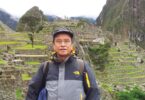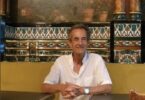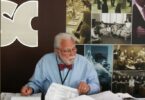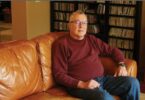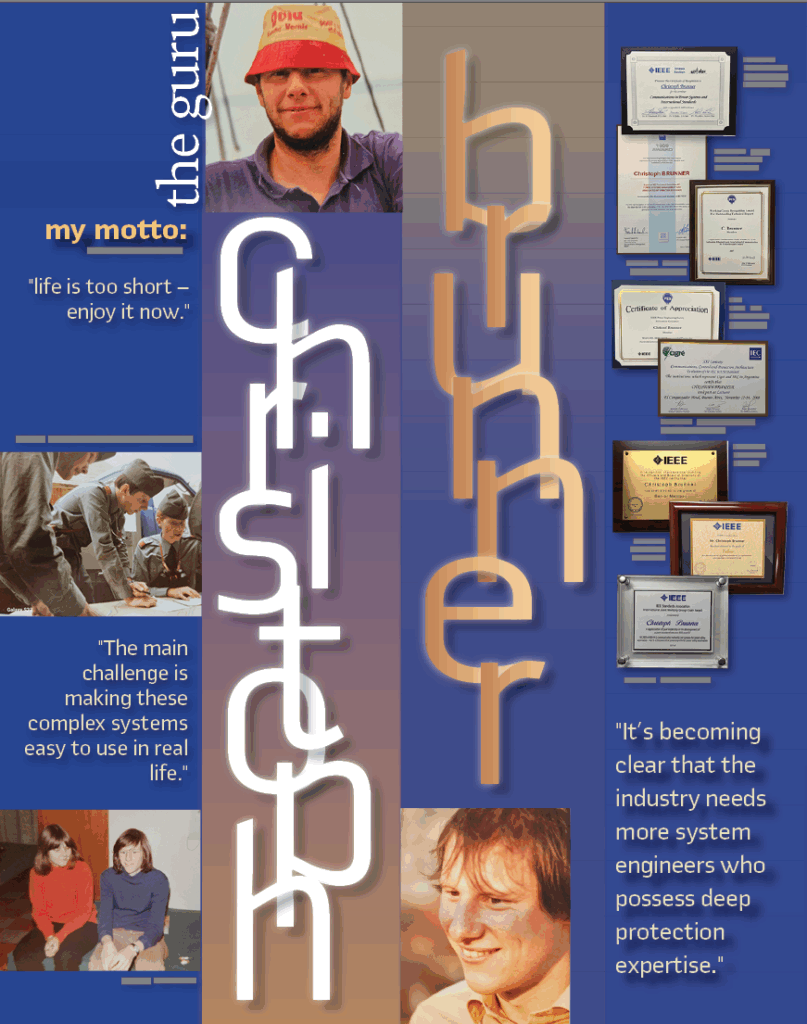
PAC World: When and where were you born?
C.B.: I was born in 1958 at the Children’s Hospital in Basel, in the canton of Basel-Stadt in Switzerland. At that time, however, my family lived in the neighboring town of Allschwil, in the canton of Basel-Landschaft
PAC World: Where did you go to school?
C.B.: I attended primary school in Binningen, in the canton of Baselland, as well as middle school (Progymnasium). After that, I spent a year at the high school (Gymnasium) in Oberwil, also in Baselland, before my family moved to the canton of Zug. There, I finished the high school (which was here named Kantonsschule) and graduated with the Matura.
Afterwards, I attended the Swiss Federal Institute of Technology in Zurich, where I graduated with a MSc degree in electrical engineering. During my studies, I also had to complete my mandatory service in the Swiss Army.
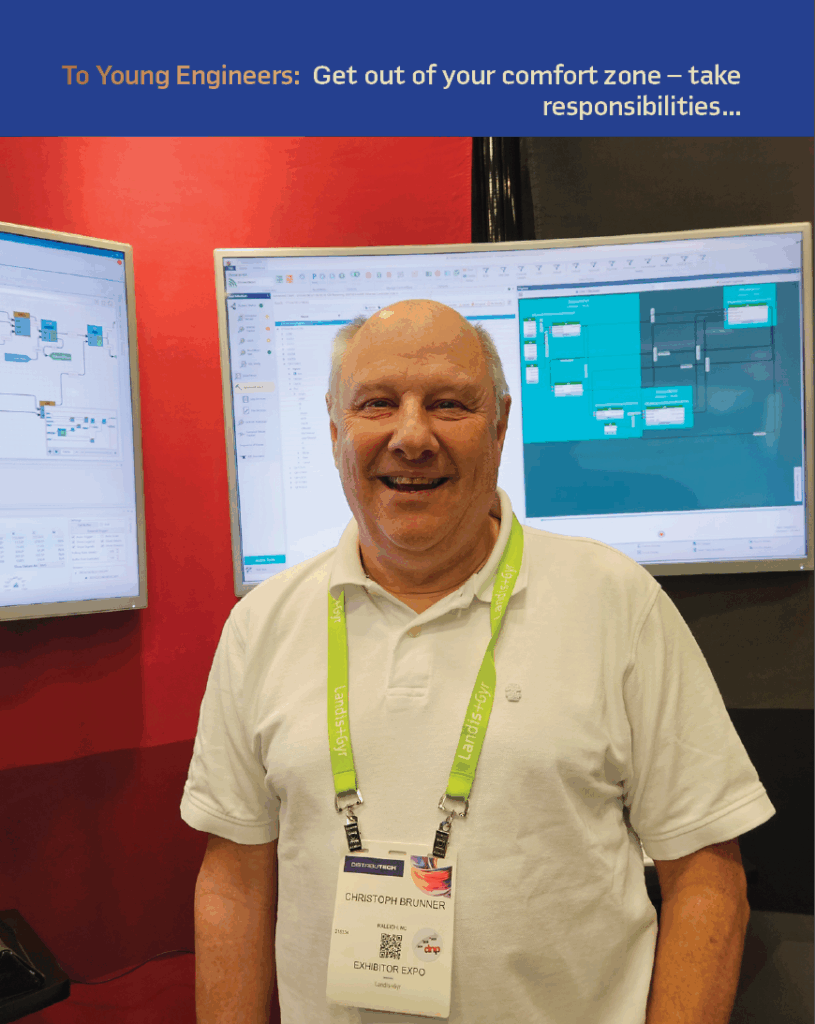
PAC World: Did you have any specific interests while you were in school?
C.B.: During the first three years of my studies, the program was more or less predetermined. In the final year, we could choose from a range of different subjects. At that point, I opted for a mix of electronics and digital technology, which also included the earliest beginnings of computer science.
In my free time, it was typical student life. After lectures, we would have a beer, and at that time, pinball machines were quite popular for passing time. In the summer, we liked to go swimming in the Limmat. It was also during my studies that I started windsurfing. Occasionally, we even formed a casual soccer team that participated in the university championships in Zurich.
PAC World: Who do you think is the person that had the most influence on you when you were growing up?
C.B.: I wouldn’t single out anyone in particular.
PAC World: Do you remember anything from your childhood that contributed to you becoming an engineer?
C.B.: Not really. During my school years, I also played viola and violin. In the final year at the Kantonsschule, we could choose specialization subjects. In addition to physics, I also chose music at that time. When it came to deciding on my studies, I was undecided for a while whether to pursue engineering or attend a conservatory and study music. Finally, I decided on engineering, but I do not really recall why I made that decision.
PAC World: Why did you decide to continue your education?
C.B.: That happened quite naturally—I had good grades at school, learning came easy to me, so it just seemed obvious to pursue higher education.
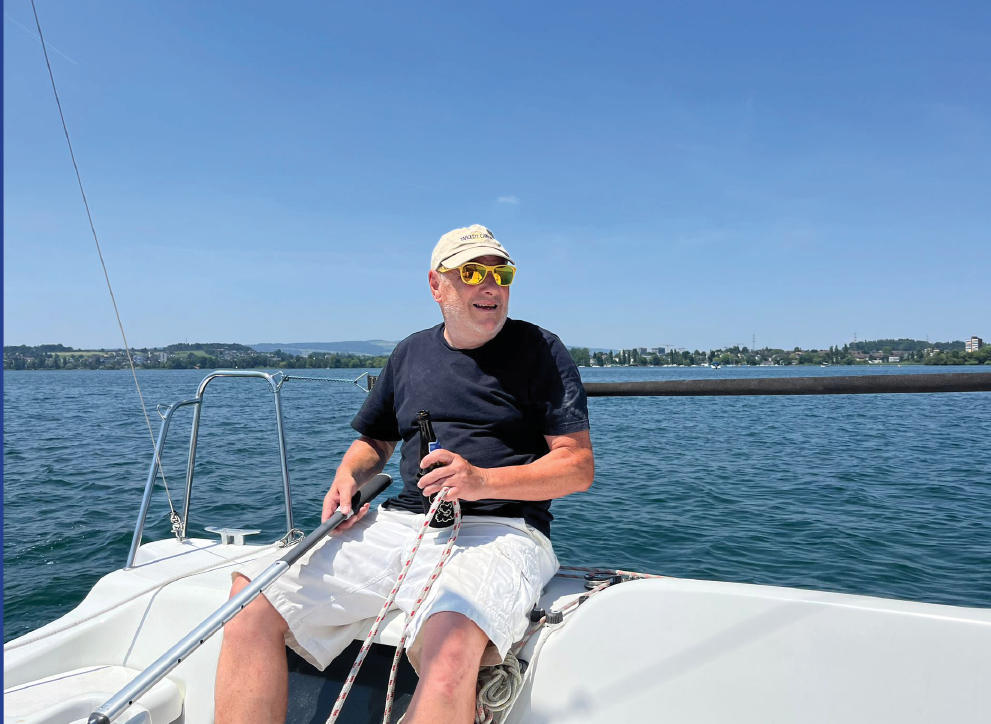
PAC World: How did you choose the university to go to?
C.B.: At that time, there actually weren’t many options for engineering studies in Switzerland. ETH Zurich is one of the best universities in the world; so it was only logical to study there.
PAC World: Did you study electric power systems while in university?
C.B.: No. In the third year of my studies, we also had electrical networks as a specialization subject, but to be honest, it wasn’t a topic that particularly interested me at the time. As I mentioned earlier, in the final year, when we could choose among different topics, I focused on electronics and digital technology.
PAC World: Did you have any other interests while in university?
C.B.: As already mentioned, the typical student life. And then, there was also the obligatory service in the Swiss Army. At that time, it consisted of 17 weeks of basic training. Afterwards, I chose to continue my training as a leader in the army; that is, first the training to become a non-commissioned officer and then to become an officer. All these courses took place alongside my studies, typically during semester breaks. At the same time, I also had to complete the intermediate exams for my degree. That’s why, after my third year, I took a gap year, during which I also undertook extended internships. This gave me my first exposure to industry and to the control of the electrical grid. My internship work involved a new type of signal for ripple control technology. At the time, ripple control technology was the method used to transmit simple signals over the power grid, for example to switch electricity meters to different tariff rates.
PAC World: What was your first job?
C.B.: My first job was at Landis & Gyr as a hardware development engineer. The activity was in the department of telecontrol technology. In the group I was in, we developed hardware modules for the RTU. My first task was to develop an interface card for connecting hard disk drives.
PAC World: Why did you decide to work for a manufacturer?
C.B.: The specialized subjects I chose for my master’s degree were in the areas of electronics, digital technology, and microprocessor systems. So, it was only natural that my first job was with a manufacturer.
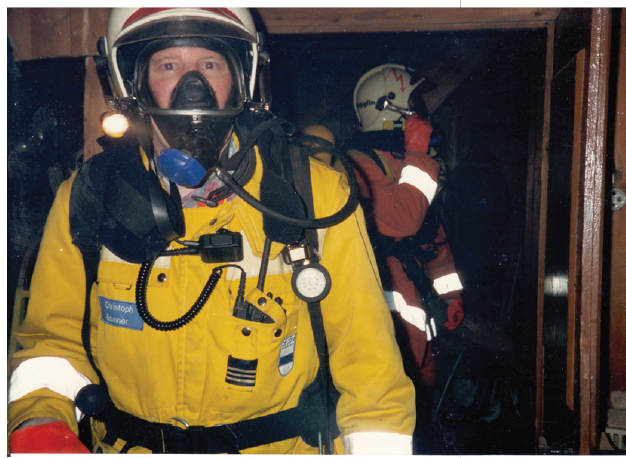
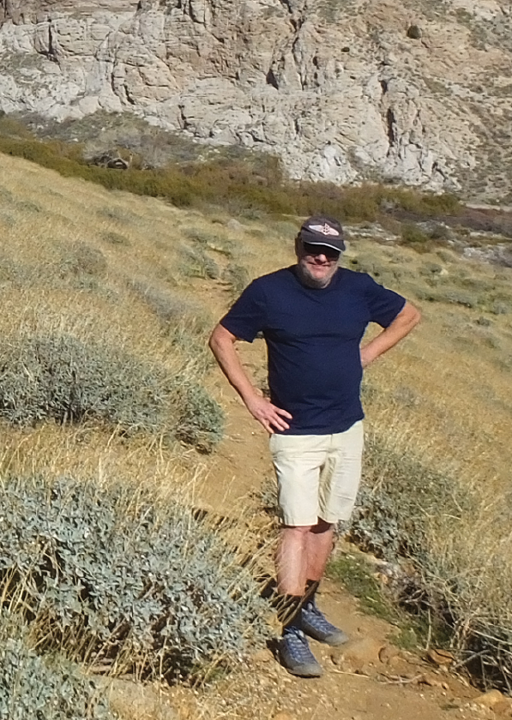
PAC World: What made you interested in communications?
C.B.: My second job was the development of a module for RTU’s communication. Some of the SCADA protocols at that time had very specific communication technology and required special hardware. The module we developed had programmable logic for the realization of the physical interface, as well as its own microprocessor to implement the protocol. After the hardware development was completed, the next step was to implement the telecontrol protocols. At that time, IEC 60870-5-101 was new and in the process of being standardized, and we had to support this protocol in our system. Thus, I was tasked with project management for the development of this protocol. The actual development was carried out by an external company.
PAC World: What was the most challenging task at the beginning?
C.B: For my work, I was able to use the latest technologies—on the one hand, hard disk drives, which were new to the market at the time, and on the other hand, programmable logic devices, which were still in their early stages. This led to two challenges: First, the development tools for programmable logic were still quite primitive. Second, Landis & Gyr maintained a large inventory with incoming inspection of individual components, a process that wasn’t really suitable for these new technologies.
PAC World: How did you become involved with IEC 61850?
C.B.: With the introduction of substation automation, we at Landis & Gyr also developed new products, primarily bay controllers. As a result, communication within the substation became an important topic. Around that time, IEC TC 57 decided to establish an ad hoc working group dedicated to communication in substations. Since I was responsible for communication protocols, I was delegated as an expert to this ad hoc working group. Later, Working Groups 10, 11, and 12 were formed to begin the development of IEC 61850. I was delegated by Landis & Gyr to Working Group 11.
PAC World: When did you become a Convener of one of the working groups developing the standard?
C.B.: When I moved from Landis & Gyr to ABB, I started at ABB High Voltage Technology in a small team that focused on process-close automation. At that time, my supervisor was the convenor of Working Group 12, which dealt with the topic of process bus, and it was planned that I would eventually take over this role. So, in 1998, I became the convenor of Working Group 12.
Later, after the completion of Edition 1 of IEC 61850, Working Groups 10, 11 and 12 were merged into WG 10 and I took over the leadership of this Working Group…

PAC World: How difficult was it to lead this development of IEC 61850?
C.B.: It was not really difficult; in fact, it was a lot of fun. In the early years, our meetings were filled with many technical discussions, which I, as convenor, had to lead. It was particularly challenging when I had a strong opinion about a topic, but it was much easier to guide the conversation when I didn’t hold a definite view myself. Later, we established several task forces that handled most of the work in small groups, so my role gradually became more of a coordination task.
PAC World: What was the most satisfying moment during that time?
C.B.: We changed the industry. I am grateful that I could be a part of it and even had the opportunity to lead part of the way.
PAC World: What do you think about the impact of IEC 61850 on the power grid?
C.B.: As I just said – we changed the industry. The influence is less on the grid itself, but more on the way we control and protect the grid and how the system is implemented to achieve this.
I believe that in the field of substations, there is almost no way around IEC 61850 anymore. In other areas covered by the standard, things are still a bit uncertain. There are various approaches, some driven by competing ideas from different people. What will ultimately prevail here will be more difficult to predict
PAC World: What are the biggest challenges with the acceptance of IEC 61850?
C.B.: People don’t want to be smart enough to understand IEC 61850.
PAC World: What do you think about the future of IEC 61850?
C.B.: Who knows about the future? Well – I believe the technology offers many possibilities for successful application in the future—not only in substation automation. We have developed data models for distributed generation and other crucial functions for the future smart grid. The extent to which the standard will be applied in these areas ultimately depends on the people implementing it. Unfortunately, when it comes to the areas beyond substations, I currently see a clear trend toward uncertainty. In fact, the proliferation of alternatives to IEC 61850 developed by different organizations is a testament to this dynamic. It feels to be simpler to create entirely new solutions rather than invest the effort needed to deeply comprehend and apply an existing standard. Some engineers get lost in technical details and miss the bigger picture. Real progress comes from blending expertise with vision—understanding both how things work and why they matter. Without this, the true potential of IEC 61850 may never be realized.
PAC World: Do you believe in IEC 61850-based wide area protection?
C.B.: You’re right—wide area applications have a lot of potential, especially because every power system is different. IEC 61850 helps by giving us flexible tools, so each utility can create solutions that fit its own needs. This means better ways to protect and control the grid that can change as technology improves. A major reason for this surge in opportunity lies in the unprecedented amount of data now captured from diverse physical locations across the grid. Modern communication technologies supporting IEC 61850 enable this information to be transmitted with remarkable speed over wide areas, making real-time coordination and advanced applications truly feasible. No longer are we limited by slow or isolated systems; instead, the ability to gather and share data instantly opens the door to smarter, more adaptive protection and control strategies that can respond to the ever-changing needs of the power system.
The main challenge is making these complex systems easy to use in real life. When engineers and utilities work together, they can build strong, reliable solutions that will help the power grid stay safe and work better in the future.
PAC World: 20 years ago, you decided to start your own company. Why?
C.B.: After more than 20 years as a development engineer for major manufacturers, I wanted to do something new. In addition, there were also changes in my working environment at that time. So it was a good time for a career change.
Since I had always played with the idea of having my own company, it seemed the right time to try something new.
PAC World: What do you think is most important for a protection engineer’s development today?
C.B.: To meet the demands of an evolving power landscape, it’s becoming clear that the industry needs more system engineers who possess deep protection expertise. While there will always be a place for specialists capable of detailed protection studies, most utility engineers should have a more holistic perspective. Today’s key competence is not just about mastering technical nuances but about understanding protection requirements in context and translating those into fully integrated system solutions. This broader focus enables engineers to bridge the gap between theory and application, fostering innovation that resonates across the entire grid.
It is this ability to connect protection knowledge with system-level thinking that is vital for advancing utility operations and addressing the complexity introduced by new technologies and decentralized energy sources. By training engineers to move beyond narrow specializations and empowering them to see the bigger picture, we lay the groundwork for resilient, adaptive, and forward-thinking power systems.
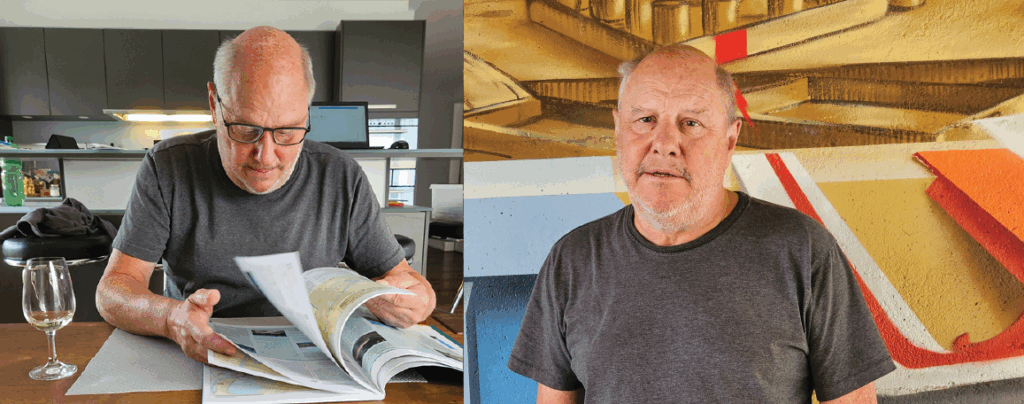
PAC World: You have been actively involved in the IEEE PES PSRC. What do you think is its impact on our industry?
C.B.: I actually see four relevant organizations for our industry: On the one hand, there are CIGRE and CIRED, which focus on the requirements of the electrical system and the applications required for them. Then there is IEC, which develops standards for technical solutions, and finally IEEE, which actually represents both aspects with a focus on the North American market.
Now specifically for IEEE PES PSRC, I think this is a very active group in IEEE, that assembles many experts and creates valuable contributions to the industry. While we have some international participants from vendors, unfortunately we only have utility participants from US and Canada.
With regard to my area of interest – power utility communication in general and application of IEC 61850 in particular, I think IEEE PES PSRC creates an important link between the international community that develops the IEC 61850 standard and the North American utilities.
PAC World: What do you believe is the best way to share your knowledge and experience in our changing industry?
C.B.: The best way to share knowledge of course is if you can get involved in a project and can guide a younger engineer to realize the project. With that however, you only can reach a limited number of engineers. Another possibility is training programs on a topic or webinars.
The typical approach is through publications in industry magazines that can reach out to a larger group. Conferences are another way to share experiences, but you may not reach younger engineers that would most benefit, as often, those are not allowed to travel to conferences.
PAC World: What do you consider the biggest challenge in your professional career?
C.B.: Owning a small consulting company, the biggest challenge is always to get the right amount of work at the right time. That was not always easy. Sometimes, customers may decide for months or years on a project, and then suddenly want to do it and believe you can start working on it immediately. That of course does not work, as you cannot just sit there doing nothing, waiting on the customer telling you to start the work.
The other challenge as a small company was to participate in the standardization working group and in IEEE PES PSRC. All the associated travel expenses and hours worked must be paid from the limited budget of a small company. That was only sustainable, as this was my only marketing activity – many of my projects I received due to personal contacts made during those events.
PAC World: What do you consider your biggest professional accomplishment?
C.B.: For most of my career, I was fortunate to do what I enjoyed and what I was passionate about. Although things didn’t always go exactly as I might have planned, in the end, it was always very satisfying. When I started my career, I never dreamed I would one day be so active internationally and, to a certain extent, gain recognition in the field.
PAC World: You have received different awards throughout your career. Is there a specific one which is the most important to you?
C.B.: While I generally don’t attach much importance to awards, there are three that I would like to mention.
The first is the IEC 1906 award, which is distributed annually to experts from the various working groups. I received it in the first year of introduction of this award in 2004. Then of course I was proud to be elevated to the IEEE fellow grade.
The third award I would like to mention was presented unexpectedly and I was not previously aware of its existence. That was the International Joint Working Group Chair Award from the IEEE Standardization Association. I received that in appreciation of the leadership in the development of the joint standard IEC/IEEE 61850-9-3.
PAC World: What do you think is your most important personal achievement?
C.B.: I am satisfied with my life and with what I have achieved in life. This is not a given and of course you can’t always control it completely by yourself, but I do think that you can make a big contribution to achieving it yourself.
PAC World: What do you think we need to do to attract more young people to our industry?
C.B.: Do we still have a disproportionate shortage of skilled workers, of young engineers, in our industry? As part of my activities, I have met young, motivated people in recent years. It is also a task of our industry to be present in universities and colleges and demonstrate that our industry can offer interesting jobs.
PAC World: What is the advice that you would give when you are in front of an audience of young people?
C.B.: Get out of your comfort zone – take responsibilities. I know, it is comfortable to stay in the background doing a cushy job while there are some of the older engineers that believe they are not replaceable can’t let go. But that is not the solution. Everybody is replaceable. And you have the skills. And at the end – it is your future that you build.
This is at the same time a message to the older of us. Don’t believe, the world will not continue without you. And don’t tell that you must stay, because nobody is there to replace you. Step back – and you will see, the gap fills faster than you think. We need to give the young engineers a chance to shine!
PAC World: You have traveled to many countries. Do you have a favorite place to visit?
C.B.: Not really. There are very different countries; some with grandiose landscapes, others with an interesting culture. It is impossible to single out any of them. Of course, I always look forward to a trip to another country that is culturally different from ours.
PAC World: Do you have a hobby or something that you like to do when you are not working?
C.B.: Outdoor activities and culinary and cultural enjoyment.
I love hiking and sailing in the summer and skiing in the winter. I also love good food and a good glass of wine to go with it. I like to visit top restaurants but also during my travels restaurants with regional cuisine. I also like to cook myself. Finally, I have been helping a winery during the grape harvest for several years.
If the opportunity arises, I also like to attend music, concerts or theater performances like operas or musicals.
PAC World: How do you mix your professional and personal life?
C.B.: Since my professional life involves a lot of traveling, I try to bring my hobbies into my travels as well. As an example, when my travel brings me into New York, I try to attend a Broadway show or go to the Metropolitan Opera. During my winter trips to the US, for more than 10 years now I go skiing for a few days in Colorado or some other ski areas in North America. Wherever I am, I try to use some of my free time to do a hike. Of course I try to visit local restaurants with local food. In general, when I have business travels, I try to add some time to visit the place as a tourist.
But I also try to reduce my travel. I needed to learn that I do not need to go everywhere. When I’m not traveling, I try to reduce my work. I have the benefit of lots of flexibility regarding working time. This allows you to sometimes prioritize your personal life and move the work to a later time. As an example, do a hike on a nice summer weekday and work on a rainy weekend.

PAC World: Do you ever consider retiring?
C.B.: Yes, I am currently in the process. Within the Working Group, we have established a succession plan. For one, there are now so-called Technical Coordinators who coordinate the various Task Forces in their respective areas. Additionally, there is now the role of Co-convenor, which means that instead of having just one Convenor, we now have two Co-convenors leading the Working Group. Up until now, I have still held the lead and chaired the meetings, but in our next meeting in September, we will carry out the handover, after which the new Co-convenor will take over running the meetings. At first, I will probably continue to attend the meetings and support the Co-convenor, but in the medium term, I will gradually withdraw.
Regarding my other activities, I have already greatly reduced my involvement in recent years. I no longer really take on new projects unless it is something truly exciting that also interests me. My goal is to be fully retired in two years at the latest. I am firmly convinced that, first, we are all replaceable; second, we must make space for young people so that they can flourish; and third, there are so many other exciting things in life to do rather than just continuing to do what I have done for the last 40 years.
PAC World: What is your favorite music?
C.B.: I have a wider range of favorite music.
PAC World: What is your favorite form of entertainment?
C.B.: I like to do my hobbies, to be with friends; I like to travel.
PAC World: Do you have any favorite foods?
C.B.: No; there is no preference on the kind of food (like meat, fish, vegetables, …) nor on the origin of the cuisine (Swiss, Italian, Asian, …). In principle, I eat almost everything. It really depends on what I feel like and then also I want to have variety. I would not put – just because it is summer – every day a steak on my BBQ. Perhaps the only aspect to mention is, that my favorite way to enjoy a meal is to have multiple small plates rather than one big dish.
PAC World: Do you have a motto?
C.B.: Not one that is written down and hangs above my desk or bed. Maybe I could summarize it as “life is too short – enjoy it now,” but that would be too narrow. I am grateful that I can live in a politically stable and prosperous country, and as such, I also want to give back to the community. The fact that Switzerland is a politically stable and prosperous country is due to its structures, which are largely based on voluntary commitment and are therefore also supported by the population. Those structures include the parliaments at various levels, various support organizations as well as the social integration of the population through diverse cultural or sports associations.
So, I also contributed my part to that. I am still active on the board of the local sailing club, which offers kids to learn sailing and get together with other kids that have the same interests. For more than 25 years, I was active as a volunteer in the fire brigade of the city of Zug as well as an instructor, teaching firefighting.
Biography:
Christoph Brunner is the President of his own independent consulting company it4power LLC based in Switzerland. He has over 40 years of experience with knowledge across several areas within the Utility Industry and of technologies from the Automation Industry He has worked as a project manager at ABB Switzerland Ltd in the area of Power Technology Products in Zurich / Switzerland where he was responsible for the process close communication architecture of the automation system. He is Convener of WG 10 of the IEC TC57 and is a member of WG 17, 18 and 19 of IEC TC57. He is senior member of IEEE-PES and IEEE-SA. He is an IEEE Fellow and is active in several working groups of the IEEE-PSRC and a member of the PSRC main committee and the subcommittee H. He is advisor to the board of the UCA international users group.




